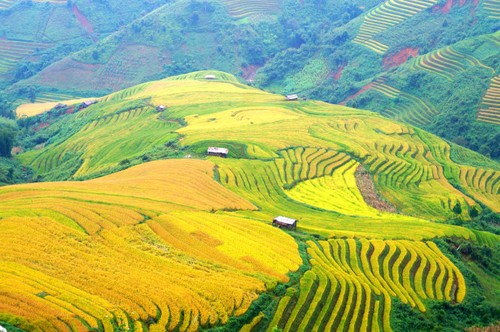 Xim Vang terraced fields in Bac Yen district, Yen Bai province Xim Vang terraced fields in Bac Yen district, Yen Bai province |
We traveled by motorbike on zigzagging paths and steep passes to Ta Xua commune, then 15km more to Xim Vang, which is about 1,000km above sea level. From afar hamlets of the Mong ethnic minority group and their terraced ripened rice fields are hidden in a sea of clouds.
Xim Vang has temperate climate all year round. The temperature in the summer ranges from 15 to 23 degrees Celsius. Due to difficult terrain and winding roads, majestic mountains, and several streams flowing from the jungles, Xim Vang has remained an unspoiled, peaceful, and poetic place.
Looking at the terraced fields of ripened rice, very few people know that more than 40 years ago Xim Vang was just a barren, sparse land. The local Mong people used to live a hard life and death with constant starvation as they applied backward cultivation methods.
Giang A Nenh, Chairman of Xim Vang commune People’s Committee, said that it was very difficult to encourage the Mong to grow wet rice on terraced fields because of the lacking irrigation system, harsh weather, and limited production knowledge. The local farmers did not think they could successfully grow wet rice.
Thanks to the State’s policies and investment, people in Xim Vang now harvest bumper wet rice crops.
“More than 40 years ago, farminghad very low productivity. Localsfrequently suffered from starvation and had to eat roots collected in the forest. At that time, the communal authorities visited every household and hamlet to help them dig water systems and reclaim land. It was very difficult to reclaim land because of lack of funding. Then more households got involved in the work to expand farm land,” Nenh said.
Walking about 15 minutes along the mountain side, a bird's-eye view of huge terraced fields opened in front of us. In recent years, the New Rural Development Program and the state’s investment in the irrigation system have helped expand terraced fields in Xim Vang. The commune now has more than 320 ha with an average yield of 6 tons per ha, twice as high as nearly twodecades ago.
Mua Thi Khua of Xim Vang hamlet, said: “In the past I grew upland rice, which had low yield and we used to be hungry. Since the commune encouragedus to grow wet rice, we have sufficient rice to eat and sell to earn money to buy clothes and learning kits for the children. We’re very happy."
Xim Vang has received more visitors in ripened rice season. Ho Thi Quynh Trang, a tourist from Hanoi, says: “This is the first time I have visited here. The mountains are superb and the rice fields are beautiful. It’s the ripened rice season now. Next time I willtake my relatives to Xim Vang.”
70-year-old Giang A Cheo went to the field with his mother when he was little. He happily talked about the changes to his homeland.
“Since tourism has developed in our homeland, we have bigger roads. People feel secure. We don’t have to migrate anywhere. Households have freezes, plough machines, rice harvesters, and other machines,” Cheo said.
When rice ripens in autumn, terraced fields on the mountainsides turn shiny yellow. Along with the Paradise of Clouds, Ta Xua tea, and Hang Dong “dinosaur backbone” mountain, Xim Vang terraced fields are becoming a unique attraction of Bac Yen district and ensuring sufficiency for the locals.